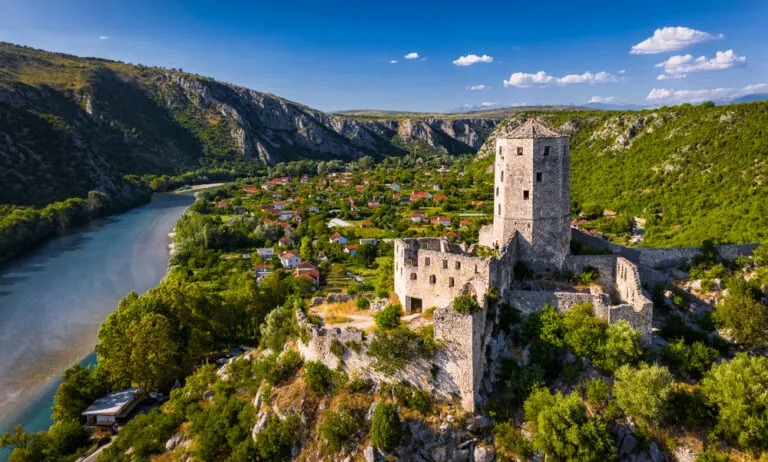Blog
The Best Times to Visit Bosnia in 2023
Why You Should Visit Bosnia
Bosnia is the northern part of Bosnia and Herzegovina and takes up about 81% of the country. Bosnia is one of those unique places where you feel you can almost step back in time.
This region is a melting pot of Western and Eastern cultures, all set in front of beautiful and time-honored landscapes and architecture.
The rugged Dinaric Alps run through the country, rising up to create a stunning backdrop for medieval castles and ancient villages that dot the countryside.
Cascading waterfalls pour into crystal-clear blue pools, where people flock in summer to enjoy the cool water and mist. But the natural beauty is only part of the appeal here.
Bosnia’s cities bring modern culture into the country while paying homage to the past. Impressive mosques, fountains, and historical sites are plentiful, as are modern restaurants, hotels, and shops.
Exploring historic towns and villages like Konjic, Pocitelj, and Blagaj, will give you a sense of Bosnia’s roots and the old ways. Medieval fortresses and stunning monasteries make these villages worth a visit.
Raft the Neretva River for an adrenaline rush, visit the gorgeous Kravice Waterfalls, or hike around the famous Lukomir Highland Village to get out and experience Bosnia.
You can take a cable car up Trebevic Mountain (of 1984 Olympics fame), see old-fashioned watermills, visit incredible parks, and check out unique rock and landforms around the country.
Some of Bosnia’s best attractions and sites need to be experienced during the right time of year. Keep reading to learn the best time to visit Bosnia so you can start planning the perfect trip!
What Is the Best Time to Visit Bosnia?
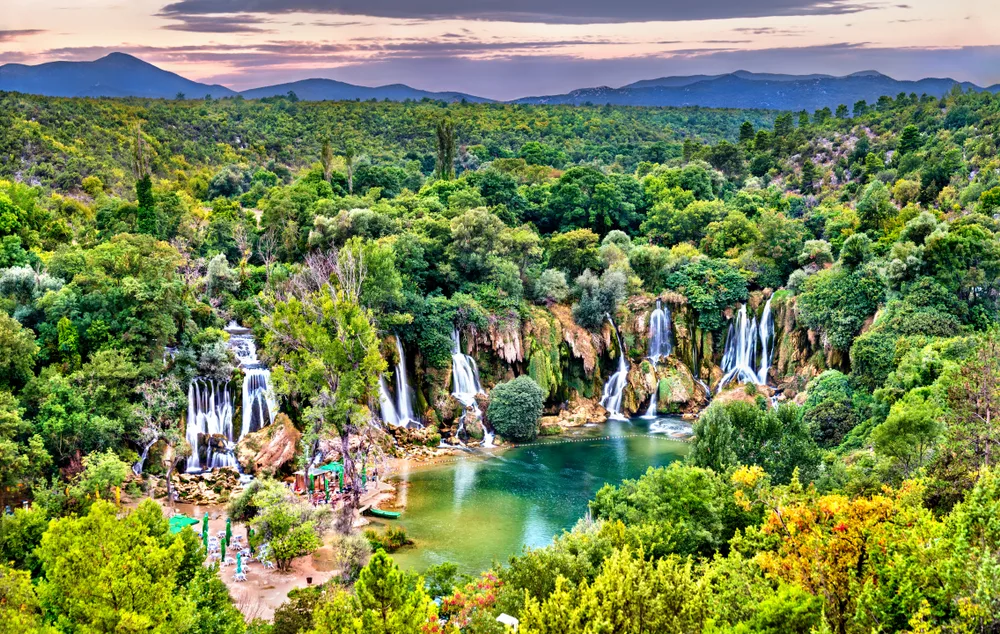
Leonid Andronov/Shutterstock
- Overall best time to visit: June-September
- Cheapest time to visit: October-March
- Least busy time to visit: October-November
- Worst time to visit: December-February
The overall best time to visit Bosnia is during the peak season in summer from June to September. The weather is warmest and you can fit in more activities and sightseeing at this time of year.
October to March is the cheapest time to visit Bosnia with some of the lowest hotel rates of the entire year during this period. Fewer tourists come to Bosnia at this time of year, so rates drop in response.
If you’re looking for the least crowded time to come, try October to November. The fall shoulder season gets very few tourists and you’ll experience a more laid-back visit.
If you can, avoid visiting from December to February. This is the worst time to visit Bosnia because it’s the coldest and snowiest time of year with limited things to do for travelers.
We’ll look at each Bosnian tourism period in more detail next and show you weather averages, average hotel prices, things to consider, and more.
Overall Best Time to Visit Bosnia
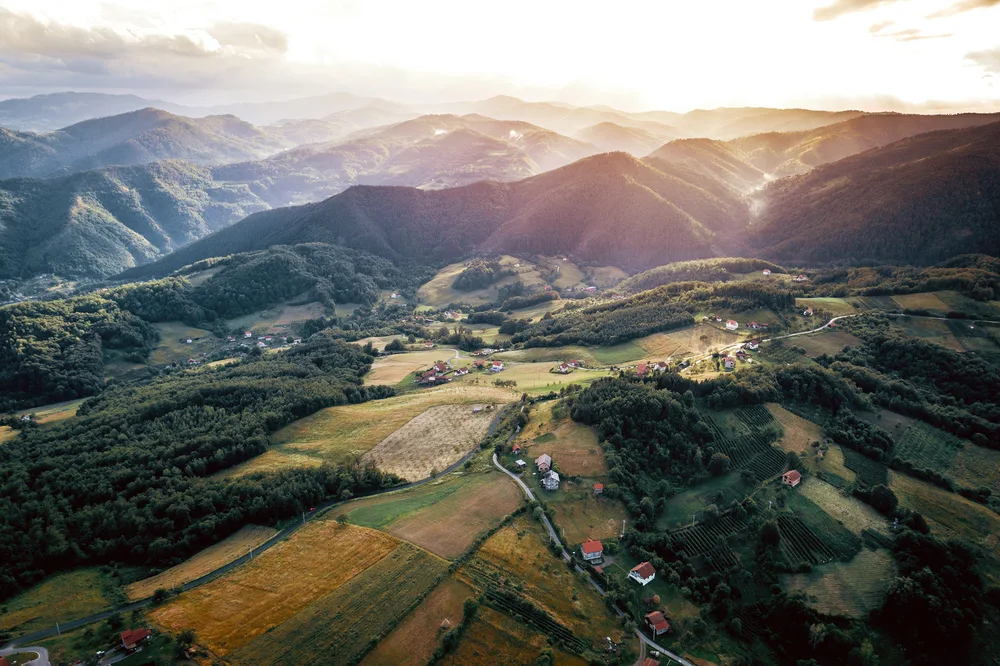
The overall best time to visit Bosnia is from June to September, during the summer peak season when the weather is great and there’s plenty to do and see in the country.
This season brings the warmest months of the year in Bosnia, with daily high temperatures ranging from 71F to 81F. It’s warm enough to feel pleasant without being scorching hot.
This is the kind of weather that’s just perfect for outdoor activities in Bosnia, like visiting medieval villages in the countryside, swimming in the lakes and rivers, or hiking mountainous trails.
June is the 3rd-rainiest month in Bosnia, getting around 2.4″ of rain throughout the month. September is the 2nd-rainiest month, receiving about 2.5″ of rain each year.
You might prefer planning to visit in July (1.7″) or August (1.8″) for drier conditions, but keep in mind that even the rainiest months only see about 7-9 rainy days during the month.
The prices on hotel rooms understandably rise during the peak season as demand soars and more people are arriving in Bosnia.
We found Sarajevo room rate averages steadily climbing from June and July ($88/night), peaking in August ($97/night), and falling dramatically in September as summer draws to a close ($80/night).
Cheapest Time to Visit Bosnia
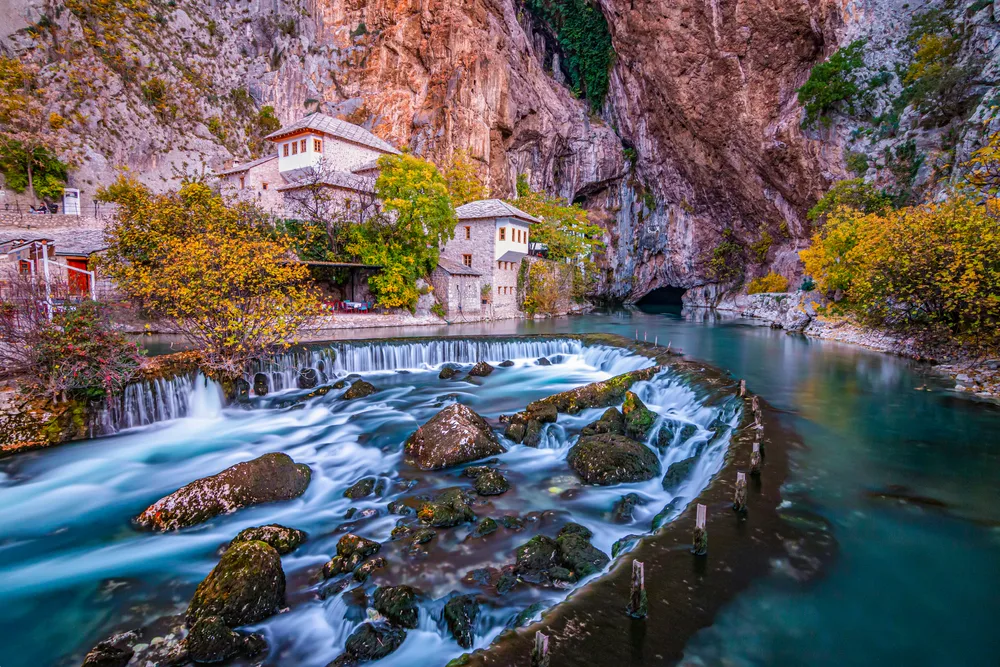
October to March should be the cheapest time to visit Bosnia, with very few tourists arriving and activities limited due to cold weather and snow.
This is especially true for the January (average 26F-38F temperature) to February (average 27F-42F temperature) period, when Bosnia is at its chilliest and snowiest.
January sees about 6.1″ of snow on average each year, while February gets around 6.3″ throughout the month. You’re sure to see snowfall at this time of year, which can be great if you’re here to try snow sports.
February is the cheapest month to visit Bosnia overall, with room rates dipping to around $63/night on average in Sarajevo. Rates are similarly low in October, November, December, January, and March.
Once March arrives, things begin to warm up in Bosnia and temperatures rise to around 41F with highs hitting the low 50s.
With colder temperatures and increased chances of snow, Bosnia doesn’t get as many visitors during the October to March period. That means lower prices on hotels and flights if you’re planning a budget-friendly trip!
We found rooms on Booking.com in the $36-$100/night range during this period, making it one of the cheapest times to visit Bosnia. You can stretch your travel budget further if you come during this time!
Least Busy Time to Visit Bosnia
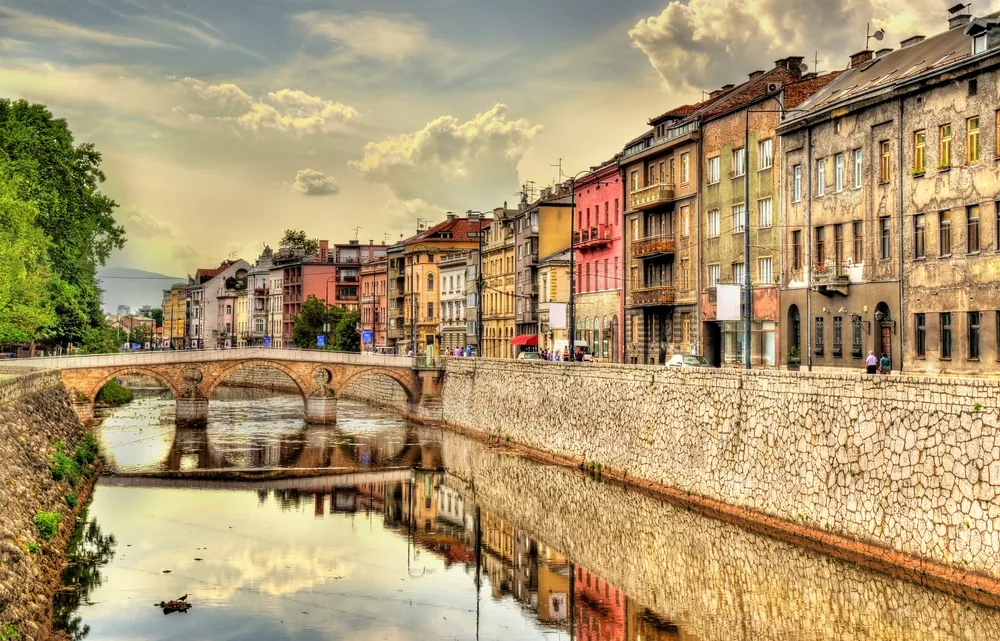
October to November may be the least busy time to visit Bosnia, offering a short window of pleasant, cool weather before it gets very cold and snowy in December.
Avoiding crowds is easy during the Bosnian fall, when very few people are coming to the country after the warm and sunny peak summer season is over.
You’ll find that it’s easy to find available hotel rooms, flights, and won’t need to wait in line at restaurants or attractions at this slower time of year.
The average Sarajevo hotel room rate is very affordable during this shoulder season period in the fall. On average, rooms in October are around $69/night and even cheaper in November at $66/night.
In Bosnia, the price of a hotel room closely follows the tourism seasons with more-visited months being more expensive and less-visited months being the cheapest.
By coming during the least busy time to visit Bosnia, you’ll not only avoid crowds and ensure plenty of hotel availability, but you’ll also pay a lot less for your trip.
Worst Time to Visit Bosnia

December to February is generally the worst time to visit Bosnia because it’s the coldest and snowiest period of the year here. You’ll be limited mostly to indoor activities and snow sports.
From December to February, the weather can be frigid and it snows often.
Average temperatures hover in the 30F-33F range at this time of year, rarely rising above 38F-42F. Snow totals range from 6.4″ in December to 6.1″ in January and 6.3″ in February.
That severely limits what you can do while you’re in Bosnia, making indoor activities and snow sports (like skiing and snowshoe tours) your best options.
If that’s not your cup of tea, this will be the worst time to go. But the good news about the “worst” time to visit Bosnia is that it’s very cheap to come during this time.
Average nightly hotel rates start around $70 in December and continually drop as winter progresses. In January, rooms are around $66/night, hitting the annual low of $63/night in February.
Things to Consider
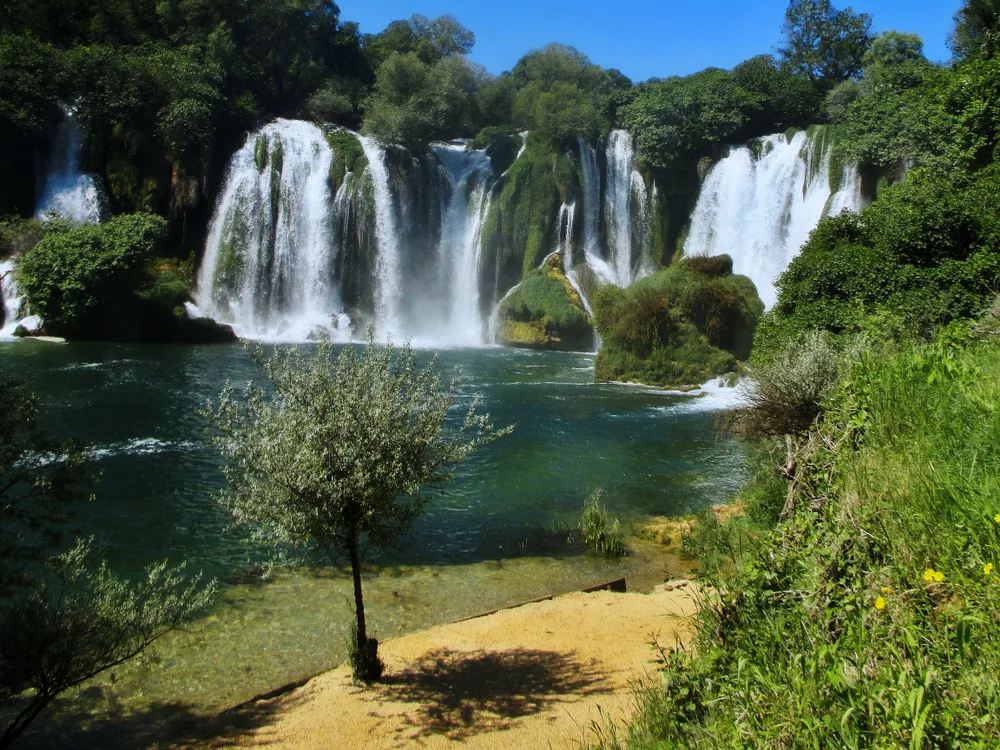
You’ll enjoy your trip to Bosnia a lot more when you know all the helpful travel tips! Here are a few things to keep in mind as you start planning.
- Take advantage of tours. Bosnia is full of historical and natural sites that are best experienced with a guide. Fortunately, you’ll find tons of tour options in Bosnia throughout the spring, summer, and fall to explore all the best attractions and landmarks! Winter tours are also available so you can enjoy some of the sights without walking in the cold.
- Look out for landmines. Bosnia’s war-torn past left landmines in some of the more rural areas. While many have been cleared in the years since, it’s still a potential danger if you’ll be hiking off the beaten path. Stick to trails and paths, look out for the bright red signs with skulls reading “МИНЕ!” (mine), and download the Mine Suspected Areas app on your phone for extra safety.
- Prepare with the right currency. Bosnian Konvertible Marks (KM for short) are the official currency, but euros and U.S. dollars are accepted nearly everywhere here. Credit and debit cards are not accepted at most places, so make sure you exchange or bring currency to use for cash payments.
- Winter is the best time for budget trips. December to February is ideal if you want to pay less to visit Bosnia. February is the cheapest month to visit Bosnia overall $63/night, and January isn’t much more expensive. You might pay around $70/night to stay in Sarajevo during the month of December.
- Snow sports are big in Bosnia. Skiing, snowboarding, and snowshoeing are favorite winter activities for locals and travelers visiting Bosnia. If you find yourself coming during the colder months to save money or avoid crowds, you can entertain yourself with a day of ski instruction, hitting the slopes at the Sarajevo Olympic Mountains, or taking a snowshoe tour!
Frequently Asked Questions
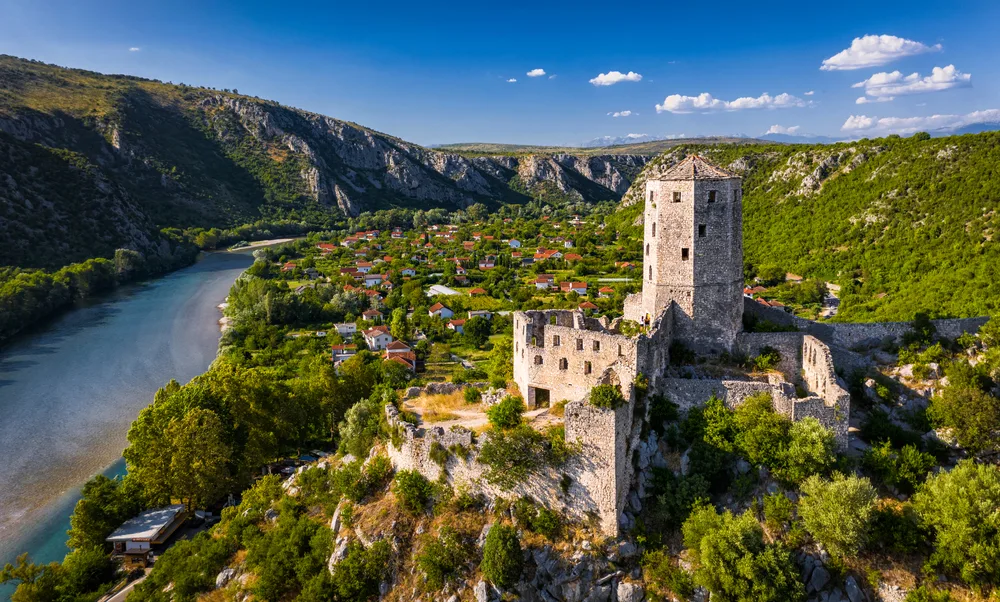
We’ve covered the best time to visit Bosnia, but you might have a few more questions about planning your visit to this historic, scenic country. Check out the most frequently asked questions to learn more!
How many days do you need in Bosnia?
Plan on spending at least 4-5 days in Bosnia to give yourself enough time to see the sights and natural beauty. Bosnia takes up about 81% of Bosnia and Herzogovina and is roughly the size of West Virginia. You’ll want time to explore the coastal region of Neum, the Dinaric Alps, the capital Sarajevo, Mostar, and many smaller historical villages and towns throughout the region.
What is the hottest month in Bosnia?
July and August are the hottest months in Bosnia, with roughly equal daily high, average, and low temperatures. Expect highs around 80F, lows around 56F, and average temperatures around 67F during this part of summer’s peak season.
Is it safe to visit Bosnia right now?
Bosnia is currently under a Level 2 travel advisory, according to the U.S. Department of State’s Bureau of Consular Affairs. Terrorism and land mines are the reason for the heightened level of caution, so travelers can safely go to Bosnia with the right safeguards.
What is the weather season in Bosnia?
Since Bosnia is the northern region of Bosnia and Herzogovina, it’s a little cooler than the south and has cold, snowy winters with moderately warm, somewhat dry summers.
The spring and fall seasons are chilly but not frigid with overnight lows in the 30s and 40s.

